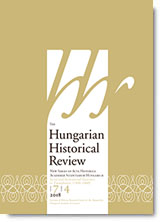A Spatial Analysis of the Socio-economic Structure of Bonyhád Based on the Census of 1869
A Spatial Analysis of the Socio-economic Structure of Bonyhád Based on the Census of 1869
Author(s): Réka Gyimesi, Daniel KehlSubject(s): 19th Century
Published by: Magyar Tudományos Akadémia Bölcsészettudományi Kutatóközpont Történettudományi Intézet
Keywords: socio-economic structure; spatial pattern; R software; segregation; nineteenth c. censuses
Summary/Abstract: In this study, we examine the social structure of Bonyhád, a multi-ethnical and multi-confessional Transdanubian town in Tolna County. We analyze the individual level data of the census of 1869 and offer a visual rendering of the results on a historical map of the town. The surviving material of this inventory covers the entire population of Bonyhád, providing a detailed picture about 6,036 inhabitants. Records include the names, sex, birth year and place, marital status, occupation and occupational status, literacy, residence, and whether the person in question was present or absent at the time the census was taken. As in Tolna County a cadastral survey was finished in 1866, a contemporary cadastral map is also available. Combined, these sources provide rich information about the spatial structure of the town, because the coordinates are also available using the mapire.eu website, which is overlaid on the OpenStreetMap and the HERE satellite base map. One can use the degrees of longitude and latitude of each household and study the census and the map together in R, a free software environment for statistical computation and graphics. Bonyhád was the economic center of a small region and had a position of strategic importance in the control of local trade routes. After the end of the period of Ottoman occupation, German settlers arrived and lived alongside the original Hungarian and Serb population. Later, a significant Jewish community settled in the area in the eighteenth and nineteenth centuries. The denominational composition of the population, according to the census of 1869, was 41 percent Roman Catholics, 31 percent Lutherans, 5 percent Calvinist and 23 percent Jewish. The analysis of the census-based information and the visual rendering of the results on the cadastral map explain valuable details about the socio-economic structure of Bonyhád, including the question of segregation, which would be difficult to demonstrate on the basis of qualitative sources, as is typically the case with historical research.
Journal: The Hungarian historical review : new series of Acta Historica Academiae Scientiarum Hungaricae
- Issue Year: 8/2019
- Issue No: 1
- Page Range: 28-51
- Page Count: 24
- Language: English

